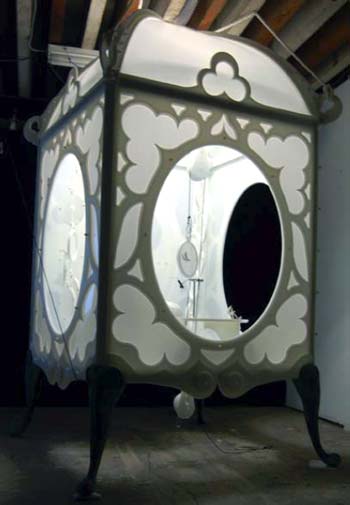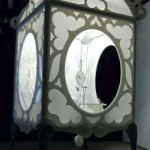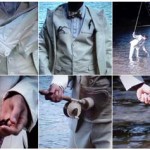By MATTHEW NASH
In his new body of work, titled “Bathyscape,” Andrew Mowbray attacks the notion of hegemonic masculinity, and employs the critical devices of post-feminism within a series of questions about his own role as a male. Through a series of performances and installations, he sets up a vision of his male character as wholly artificial, enhanced by props and devices that are only logical within the extreme artificiality of the persona he has created.
In Mowbray’s world, the trappings of a masculine life are tied to the activities in which men are supposed to be most ‘unfeminine’. In “Bathyscape,” this is represented through the act of fishing. The series of projects culminating in the installation “Palingenesis” (but consisting of individually titled and discussed pieces) posits Mowbray as a kind of über-bachelor, a wise-cracking dandy who goes fishing because it is part of his manly role, yet who cannot help but bring this knowledge of the artificiality to the act.
Thus, we are presented with “Bachelor Suit,” a white vinyl leisure suit with a plastic cod-piece designed to hold “Rod and Reel”, a stylized fishing reel. A pink plastic “Creel” is also present, its color and oddly feminine form a strong contrast to the bluntly phallic suit and rod.
As an installation, these various elements inspire a number of notions about manliness, artificiality, and how we engender actions and objects. There is an obvious reference to Beuys in the suit, yet where “Beuys related women to various creatures symbolic of innocence” [1] Mowbray hints that gender roles are often buried under layers of confusing expectations.
The culmination of these diverse elements, though, comes through the video “Walden Pond,” which depicts Mowbray in his “Bachelor Suit,” “Rod and Reel” in hand and pink “Creel” slung over his shoulder, knee-deep in Walden pond attempting to fish. Here Mowbray slams together his references to make a humorous and sly result, enacting his own Beuys-type ‘action’ in a location rich with historic connotations of simplicity and naturalism. Witnessing Mowbray trying to fish in his ridiculous plastic getup in any pond would evoke all of his ideas easily, but the deliberate choice of Walden Pond forces us to engage with a longer and more elaborate history of masculinity than just our present moment. Mowbray is not asking us about the role of men in a post-feminist world; he is asking whether the role of men has not always been somewhat contrived, and that even the natural philosophies implied within the reference to Walden are not any less artificial than a man fishing in a plastic suit.
The centerpiece of the “Bathyscape” installation is a collection of devices, wires, hooks, pulleys and a large plastic chamber large enough to fit one person. The chamber is accessed by an ornate plastic door that unlocks like a submarine hatch. It is fed by a series of vents that connect to a large device that appears to be an air pump, implying that once a person is within the chamber they are cut off from the world. As a set of objects, the chamber and its ventilation are both imposing and appealing, covered in ornate carvings that mimic Victorian designs, yet made of plastic and wholly contemporary. The urge to climb inside the chamber (as one has the urge to try on the “Bachelor Suit”) is undercut by the perception that the seemingly luxurious insides may be a trap, a site of some clinical invasion. The pure white cleanliness of the entire object only reinforces this clinical feeling.
Again, as with the “Bachelor Suit,” Mowbray is not content to imply what actions his objects might facilitate; he embodies these actions for us and causes his objects to become activated by their use. Near the “Bathyscape” objects, a large video projection shows us Mowbray within the chamber, meticulously cutting off his own hair. The various utilities needed for the task, such as scissors and razors, enter the pod through a series of pulleys and wires, and Mowbray contorts himself in the small space to remove his hair. The footage looks a bit like old NASA footage of astronauts in stress tests, and the lack of sound enhances the sensation that Mowbray is cut off from the world, searching for an identity through this series of actions, trying to communicate through the multiple layers of glass, camera lens, language, gender and expectation.
With “Bathyscape,” Andrew Mowbray has created a masterpiece of conceptual work. The show is rich in both style and content, its references broad and well-considered, and it is a body of work that leaves its viewers with many great things to think about. Do not miss this show.
- Andrew Mowbray, Bathyscape, (detail) polyethylene plastic, acrylic, bronze, 2005-6
- Andrew Mowbray, Palingenesis, 2005. Installation features “Bachelor Suit”, “Catch and Release”, “Rod and Reel”, “Cabinet”, and “Creel”
- Andrew Mowbray, Walden Pond, photographic stills and video, 2004.
----
[1] - "Joseph Beuys: Staging Sculpture" by Mark Rosenthal, from the catalogue Joseph Beuys: Actions, Vitrines, Environmentspresented at the Tate Modern.
"Andrew Mowbray: Bathyscape" is on view May 18 – June 30, 2007 at Space Other.
All images are courtesy of the artist and Space Other.







